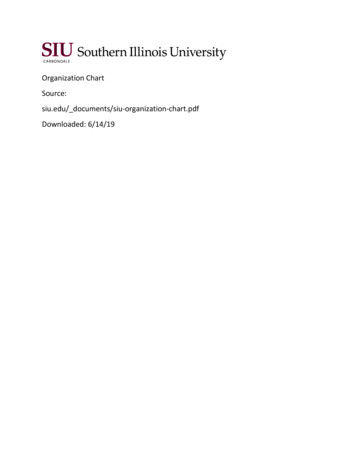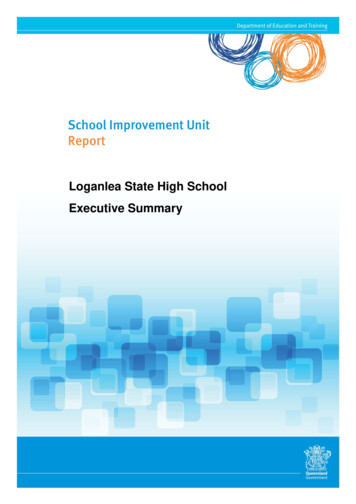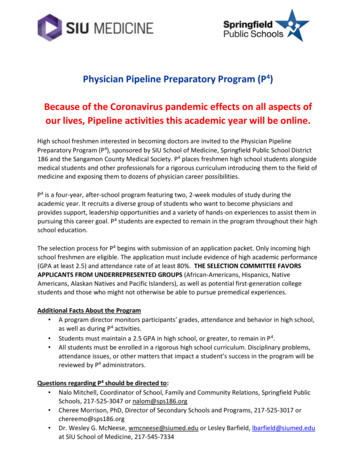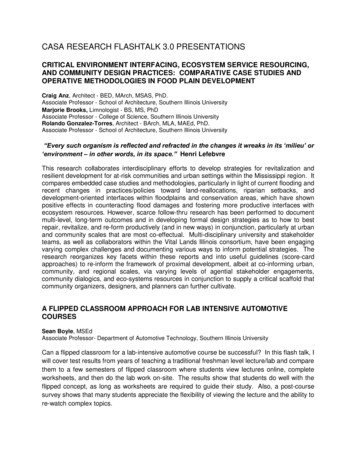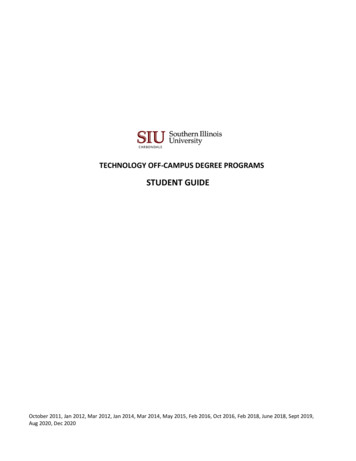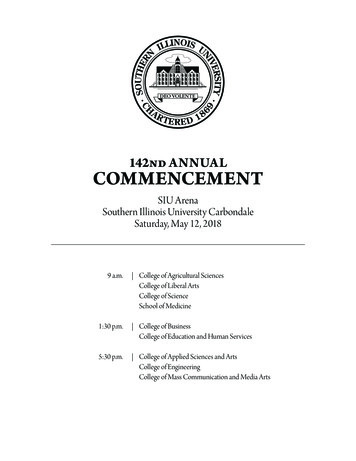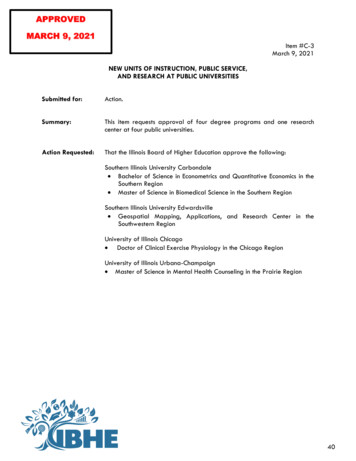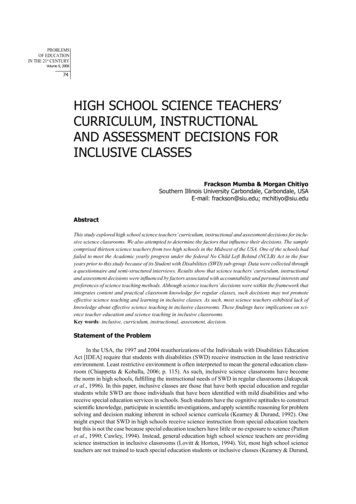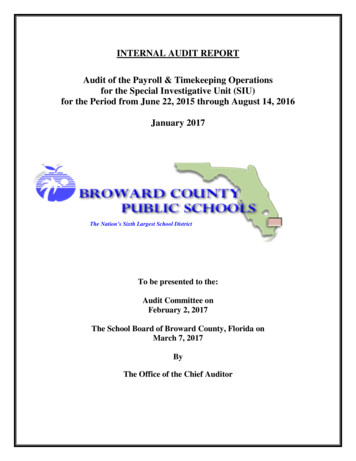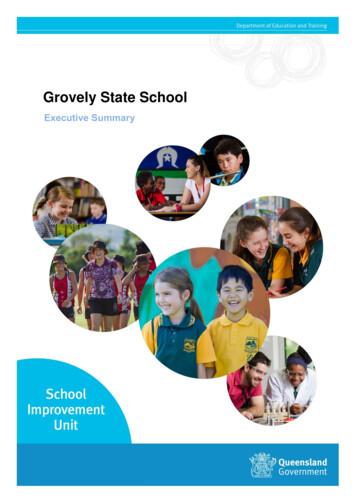
Transcription
Grovely State School
Contents1. Introduction . 31.1 Review team . 31.2 School context . 41.3 Contributing stakeholders . 51.4 Supporting documentary evidence. 52. Executive summary . 62.1 Key findings . 62.2 Key improvement strategies . 82
1. IntroductionThis report is a product of a review carried out by a review team from the SchoolImprovement Unit (SIU) at Grovely State School from 2 to 4 of May 2017.The report presents an evaluation of the school’s performance against the nine domains ofthe National School Improvement Tool. It also recommends improvement strategies for theschool to consider in consultation with its regional office and school community.The report’s executive summary outlines key findings from the review and key improvementstrategies which prioritise future directions for improvement.The schools will publish the executive summary on the school website within two weeks ofreceiving the report.The principal will meet with their Assistant Regional Director (ARD) to discuss the reviewfindings and improvement strategies.For more information about the SIU and reviews for Queensland state schools please visitthe SIU website.1.1 Review teamLesley VoganInternal reviewer, SIU (review chair)Rodney WoodPeer reviewerRichard BarriePeer reviewer3
1.2 School contextLocation:Dawson Parade, GrovelyEducation region:Metropolitan RegionYear opened:1956Year levels:Prep to Year 6Enrolment:384Indigenous enrolmentpercentage:11 per centStudents with disabilityenrolment percentage:5 per centIndex of Community SocioEducational Advantage(ICSEA) value:1034Year principal appointed:2016Full-time equivalent staff:30.58Significant partnerschools:Mitchelton State High SchoolSignificant communitypartnerships:Hope City Church, Montessori Australian Foundationconsultant, Australian Red Cross, Arana Leagues ClubSignificant schoolprograms:Read It Again, guided reading, Explicit Instruction (EI),reviewed coaching framework4
1.3 Contributing stakeholdersThe following stakeholders contributed to the review:School community: Principal, deputy principal, two Head of Curriculum (HOC), Business ServicesManager (BSM), two administration officers, two Support Teacher Literacy andNumeracy (STLaN), 16 teachers, music specialist, physical education specialist,six teacher aides, chaplain, cleaner, facilities officer - grounds, Parents andCitizens’ Association (P&C) president and treasurer and tuckshop convenor.Community and business groups: Australian Red Cross program coordinator and Young Men’s ChristianAssociation (YMCA) Grovely Outside School Hours Care (OSHC) coordinator.Partner schools and other educational providers: Deputy principal of Mitchelton State High School.Government and departmental representatives: ARD.1.4 Supporting documentary evidenceAnnual Implementation Plan 2017Explicit Improvement Agenda 2017Investing for Success 2017Strategic Plan 2014 - 2017Headline Indicators (Semester 2, 2016)School Data Profile (Semester 1, 2017)OneSchoolSchool budget overviewSchool Personnel MapSchool Coaching FrameworkSchool improvement targetsSchool differentiation plannerPedagogical frameworkSchool writing targetsSchool Guide to Curriculum PlanningSchool newsletters and websiteResponsible Behaviour PlanSchool Opinion SurveyWhole School Curriculum FrameworkSchool Guide to Curriculum PlanningWhole school Assessment andReporting ScheduleSchool Professional Learning Communityoverview5
2. Executive summary2.1 Key findingsThe school has a unique context that embraces two learning pathways including amainstream and Montessori learning program.The two learning pathways offer parents a choice of educational provisions for their child.The school leadership team and staff members have developed a narrative that describes acommitment to the social, emotional and academic development of all students enactedthrough high expectations and relationships. Self-management, critical and curious thinkingand working collaboratively are viewed as enablers to high quality successful learning.The school views parents, families and community members as important partners inthe life of the school.Parents play an active role in the school and are directly involved in their child’s education. Awelcoming and orderly environment greets people upon arrival at the school. Allstakeholders comment regarding the strong sense of community and the positiverelationships that are built and exist between students, staff members, parents andcommunity members.The school leadership team has established an Explicit Improvement Agenda (EIA)that outlines three priority areas.All staff members are united and committed to improving learning outcomes for all students.Staff members are familiar with the agenda of writing and reading, differentiation and aculture that promotes learning. The EIA is accompanied by some broad targets andevidence sources for success. Timelines for actions and strategies for measuring progresstowards targets are yet to be further developed.The school leadership team views reliable school data as essential to the effectiveleadership of the school.Staff members are included in a range of data conversations to clarify the learning needs ofstudents and their progress over time. The school leadership team utilises a range ofreflection tools to lead data discussions with teachers regarding individual student learningprogress and to identify student learning needs. Teachers are strengthening their skills toutilise data to inform the next steps of student learning and reflect and self-evaluate theirteaching practices.6
The school leadership team acknowledges the importance of open and transparentdecision making and the need to develop cohesive and effective teams of teachersthat work within their year level, across year levels and across school learningpathways.Collaborative Professional Learning (CPL) teams work closely together and team leaders actas a conduit between the sectors and the school leadership team. All staff memberscomment positively regarding participation within their sectors. The school leadership teamidentifies the next step as developing stronger links across sectors.The school has a plan for curriculum delivery that is referenced to the AustralianCurriculum (AC) and utilises the resources from Curriculum into the Classroom (C2C)units of work and assessments and the Montessori cycles of learning.The whole-school curriculum framework outlines the ‘Grovely Essentials’ for theimplementation of the AC across learning areas. Teachers participate in some internal andexternal moderation sessions. School leadership team members articulate the need tostrengthen moderation processes and practices to assist teachers to develop a deepknowledge of the required achievement standards to support high expectations for learning.Staff members clearly articulate the belief that all students can learn successfullygiven the time and appropriate learning opportunities that motivate and supportindividual students.The school is refining the way student support is organised and implemented. A casemanagement system utilises school and classroom data and teacher knowledge of studentsto target the levels of support to the needs of the students. Interventions are tailored andresources are targeted to support students in a timely and sustained manner. This approachis viewed as putting the needs of all students first and effectively utilising school resources.All staff members are committed to the continuous improvement of their teachingpractices.The school leadership team has developed an array of strategies to assist teachers tocontinue to share and develop a deep understanding of how students learn. Most teachershave high levels of confidence in the fields they teach and many share their expertise andguidance with new and beginning teachers. Many teachers take an active leadership rolebeyond the classroom and are team leaders for CPL teams, coordinate the Montessoriprogram and mentor beginning teachers.7
2.2 Key improvement strategiesDevelop short-term and long-term school timelines and targets for the implementation of theEIA.Continue to develop the data literacy skills of all staff members through in-depth datadiscussions between the school leadership team and amongst staff members that informstrategies for continuous improvement of student learning and self-evaluation and reflectionon teaching practices.Continue to build on school strategies including coaching and collaborative teams acrosssectors and learning pathways to further the culture of a school-wide shared responsibilityfor student learning and success.Strengthen internal and external moderation processes to enable teachers to deepen theirunderstanding of the AC standards and focus on areas for improvement.Continue to develop and embed the school case management model.8
Improvement Unit (SIU) at Grovely State School from 2 to 4 of May 2017. The report presents an evaluation of the school's performance against the nine domains of the National School Improvement Tool. It also recommends improvement strategies for the school to consider in consultation with its regional office and school community.

